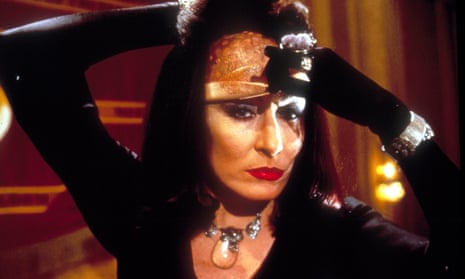Last week saw the 25th anniversary of The Witches, a movie that arguably reflects what’s now become an increasingly dated approach to witches and witch culture.
In the film (based on Roald Dahl’s 1983 book of the same name), a little boy and his grandmother rid England of its horrendously disfigured witches (including The Grand High Witch, played by Anjelica Huston) by turning them into mice.
In 1990, this depiction made sense. Witches in pop culture were a far cry from the chic interpretations seen in American Horror Story: Coven or movies like Practical Magic. Dahl’s witches didn’t have hair or toes, whereas now witchcraft is less gruesome and more glamour or goth.
“Stylistically speaking, people have conflated witchcraft with various subcultures that present a similar aesthetic – goth, grunge,” explains writer Carly Lewis. “If I’m being honest, I think it’s because dark lipstick made a comeback, and tanning fell out of fashion.”
Which, as far as writer Fariha Roisin is concerned, marks a big distinction between the way movies and TV depict witchcraft and what witchcraft actually is.
“Something like The Craft is totally empowering and subversive as it’s about harnessing your power,” she said. “Actual witcher is so much more complicated and internal than what we see in pop culture.”

This makes sense. As Roisin also explains, The Craft’s (1996) mantra of “we are the weirdos” coincides with the 90s’ grunge and punk themes, as well as the decade’s embrace of individuality and otherness. But as the decade progressed, accessibility replaced the fear-mongering that had normally been reserved for pop culture outsiders. Sabrina the Teenage Witch (1996-2003) positioned its teen witch heroine as just like us, while Charmed (1998-2006) promoted sisterhood over ostracism and, yet again, positioned witches as the heroes. But the lightheartedness of the 00s soon gave way to the bleakness of the 2010s.
“I think for a while witches were in a funny, lighter place,” says writer Hazel Cills. “But [it’s] getting darker. I really think it’s been all over the place, but I do think witches [in pop culture] are more self-aware and lean away from horror.”
This self-awareness is arguably a reflection of this generation’s own willingness to gaze inward. Witches in pop culture now reflect the feelings of isolation, confusion, or the need to band together for a greater good – especially if you’re a woman.
“I think a lot of feminists, like myself, have romanticized witchcraft for a few reasons,” Cills continued. “One, it’s a woman using powers to change a world that doesn’t like her in the first place. A witch tale is a feminist fantasy because it’s about having a physical, mystical power that can create real, dangerous change in a world that would rather take power away from them.”
“Witches are historically ugly, hag-like, living on the edge of town. And I love and relate to it because I think there’s a power to being a woman people are afraid of – that men are so threatened by.”
This concept of reclamation – or more specifically, the reflection of society’s relationship with women – is a point Roisin agrees with, too.
“It’s emblematic, entirely, of our society’s struggle with the polarizing faces of women – the all bad versus all good,” she says. “They’re all just a larger story of absolute power corrupting absolutely, so be aware, be afraid, and be good. It’s the quintessential cautionary tale, which makes me think that larger society knows not to make a witch mad.”
Hollywood is paying attention too. Next year, The Witch – a chilling thriller that earned critical acclaim at Sundance – will transport audiences to the early 1600s, where a New England family will find themselves looking for and battling a witch and subsequently falling apart mentally, emotionally and physically. WGN’s Salem follows a similar formula, with the series revolving around the 1692 trials and the possibility that witches – in the folkloric sense – were real. Paranormal Activity’s sequels eventually revealed that there was a coven behind all the unwanted feng shui.
“I don’t think there are any realistic portrayals of witchcraft in modern pop culture,” argues Lewis. “Witch characters bring a world of stereotypes to play up. Bewitched wasn’t scary because it would not have been suitable to scare that show’s [note: or era’s] audience. It was a family sitcom. The Craft was for people who wanted to feel eerie and bad and freaked out.”
Which makes sense. For pop culture to be digestible, it usually has to change enough to appease the masses. Since Anjelica Huston took off her wig in The Witches, we’ve made some progress in terms of evolving the relationship between witches and pop culture. They may be trendy, but at least we’ve broken from lore that dictates witches are ugly and evil.
“I think there’s definitely room for both funny and cute versus dark and scary depictions of witchcraft,” Cills maintains. “I think they’re so contrasting because witches are really like a tabula rasa now – it’s not like vampires or werewolves or other archetypical monsters where there’s a rulebook. I like them for all the reasons above.”
“I like scary witches because I think there’s a lot of power in a woman being really scary and not in a sexy, Quentin Tarantino way; in a cold-blooded, monstrous way. But I also love things like Kiki’s Delivery Service, where it’s about kids saving the world and changing their environment with magic in fun ways.”
Maybe it’s like Practical Magic once famously said: there’s a little witch in all of us.

Comments (…)
Sign in or create your Guardian account to join the discussion